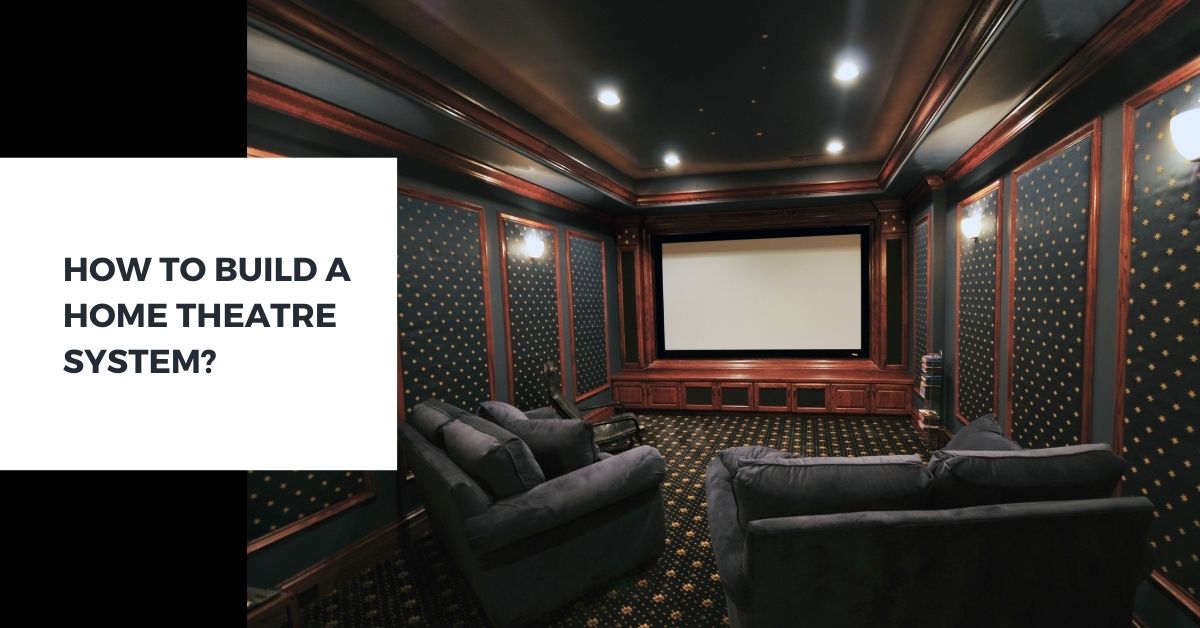If you are planning to build your own dream home theatre system, then you are at the right place. We get you all the steps and tips for how to build a home theatre system.
Designing your home theatre system has many benefits, as you will be able to satisfy your expectations from the design and tech elements. It’s not only about getting a high-end home theatre system, you need to have a perfect setup to get theatre like experience. For this to happen, you need to plan all your equipment that fits the home theatre development plan.
It doesn’t matter if you are a movie lover or sports enthusiast, building a proper home theatre room is an ideal way to enjoy the sound experience. When you design all the attributes, you will be able to feel the difference in the audio performance.
The home theatre system can easily be set up in your residential home or a residential apartment flat. It all depends on the space and the room that you are going to allocate for the home theatre system. With the combination of home theatre equipment, you can design and get your dream home theatre room.
How to build a home theatre system?
This guide has been carefully evaluated and researched based on various factors that the consumers have developed the home theatre system for their home. Based on their feedback, we have collected the data, and below are some of the major points that you need to keep in consideration while building a home theatre system.
1. Budget
Before you start developing your dream home theatre system, the first thing that you need to do is ascertain the budget. Because building a home theatre system will not be economical. It depends on your requirement from home theatres that influence the budget.
Let’s take a common example if you need a display, speakers, audio players, interior design, furniture, and all other fixtures. Based on that, you can easily come up with a budget plan that you can allocate for designing the home theatre system. You can also consult with your interior designers to get a quote for it.
2. Allocate a space
Space allocation is another major criteria when it comes to designing your home theatre system. You need to decide which room will be ideal for defining it for the home theatre system. You can consider factors such as lack of windows or closed rooms with lesser natural light. The reason for this is you will be getting a better sound experience in a completely closed room that doesn’t have any windows.
This can be decided on the basis of the suggestions provided by your family members. You can even check out the design inspirations whether the room is compatible with it or not. It will give you clarity in terms of which room needs to be allocated for building a home theatre.
3. Decide a display unit
There are two major popular choices when it comes to building a home theatre system in terms of display. The first one is opting for a big television screen size or using a projector screen. It all depends on your requirements and expectations that you want to meet by building a home theatre.
The popular choice would be a 70 or 100 inches HD LED TV. These displays are commonly used to build a home theatre system. Currently, in the market, you find various technologies involved in making the TV screen look better. And it also has various features that support internet streaming and other integration options. But you need not mandatorily stick with this option, as you can consider the projector screen as well.
Projectors screens are ideal if you have a large room that can easily accompany several people. If the room distance between individuals to the screen is above 15 feet, then it is ideal to opt for a projector screen. The projector screen has many advantages when it comes to viewing the picture on a big display. It is also cost-effective when we compare it to a large LED television.
Both the options have their own advantages, it all boils down to your requirement and the budget allocated for opting for a display.
4. Check which home theatre speakers suit your needs
Now we come to the major part of building a home theatre system. Without the good speakers, it’s of no use building a good home theatre system. The speakers are very important when it comes to getting you a theatre-like sound experience.
When you go shopping for home theatre speakers, there are many options. It ranges from 5.1 surround sound home theatre speakers to 9.1 speakers. Sometimes you can also find 5.2 and 7.2, as it is accompanied by two subwoofers which helps you to get better audio quality.
The ideal option would be referring to a 5.1 sound or a 7.1 channel surround home theatre speaker. This is popularly used by many consumers and they have really enjoyed what they have purchased. As each speaker is equally important when it comes to giving the sound output, it will be better if you opt for multiple channels associated with a subwoofer.
Prefer home theatre speakers that come with Dolby Atmos technology, as it is the primary requirement when it comes to creating home theatre systems. It delivers you the same experience as you get in the multiplex. Also, check whether the speakers support multiple audio formats at high volume without distortion.
5. Positioning the screen and speakers
The position of the screen and speakers is very important. Because when you place the equipment correctly, then there are chances for you to get an amazing immersive sound experience. You can usually see this pattern in the multiplex which has its own layout structure.
The speakers can be positioned on the wall and ceiling depending on the type of layout you have planned. It helps in the seamless integration between the speakers if they are based on wireless technology. Simultaneously, the screens can be placed on a stand or can be attached to the wall. You need to have a proper floor plan so that you can position these equipments for better results.
Whether you are going to position the speakers in the center or on the ceiling, analyze the measurements and maintain the distance between yourself and the speakers. This is also applicable to the way you position screens as well. To get a better display and sound experience, you need to maintain minimum distance to enjoy the audio and visual quality.
6. Plan home theatre room interiors
The interiors also play a key part when it comes to delivering an amazing sound experience for you and your family members. Here are some of the major points that you need to watch out for when it comes to designing the home theatre room.
Wiring
Always ensure that you use a good quality of wires to connect your television with the speakers across the room. Place the wires correctly so that you are aware of the flow of cables from your ceiling or within your wall. It all depends on the way you wish to position the cables. By marking the locations accordingly with respect to left, right and center. It will be easy for you to navigate the wires and connect them.
Lighting
Try to opt for a creative lighting system that comes similarly to the way they place in the multiplex theatres. The position of the lights can be on the floor or on the ceiling based on your desire. Use the combination of dim and bright light so that it caters to whichever scenario you wish to watch a movie or sports. This pattern helps you to make your home theatre the same as a multiplex movie theatre.
Soundproof your walls
If you don’t want to disturb your neighbours and get a 3D effect, it will be the ideal choice for you to soundproof your walls. It all depends on the way you are going to design the walls of the room and introduce the layout within it. You can use soundproof drywall that is available in the market and also make use of sound dampening materials to give a complete soundproof experience.
Accommodations
The accommodation can be chairs or sofas depending upon your requirement you wish to place in your home theatre room. If you want to accompany many people within the room, it will be better if you take a comfortable chair. If there are limited members within your family, you can opt for a theatre styled sofa. Also, look for creating an elevated floor Experience so that all the members of your family can easily view the screen from any angle.
Suggested read: What color to paint a home theatre room?
7. Opt for future proof designs and Technology
As it is a one-time investment, you need to carefully evaluate all the alternatives before you purchase for your home theatre room. It can be the display unit, home theatre speakers, and the type of furniture that you are going to use for building the home theatre room.
When I mention opting for future-proof designs and technology that means you need to prefer the most trending devices that easily can last for a decade. This ensures that you need not spend any more expenses after a few years.
The display unit and the speakers are some of the primary things that you need to give extra attention to. Opt for the latest developed technologies within these equipment so that you will enjoy a better theatre experience and not be concerned about its future.
Concluding thoughts
Evaluate all the points that have been mentioned in the blog properly so that you should not mess up by investing in the wrong equipment which is not ideal. It can be the layout designs or the equipment that you are purchasing for the home theatre room.
The smallest attributes that are involved in building a home theatre system should be given close attention to detail. Like the dark paint for walls, opting for simple fixtures, covering the display unit, eliminating reflective items, ventilation, and many other factors. When you are able to address these, you will get the perfect solution for how to build a home theatre system.
Further, read:

